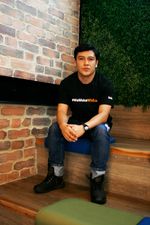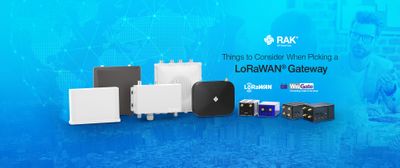Developing complete IoT solutions with AWS IoT Core for LoRaWAN® and RAKwireless WisGate Edge
Let's start with something simple: AWS is a cloud service, that is, it is a set of tools that allow you to manage, process and visualize data, which will help users to make decisions in any business. But it is useful when the data is already stored on an IoT platform, so RAKwireless handles the process of generating and transporting this data to the cloud, which is made possible by end-nodes and gateways. Now let's dive into each part of this process.

Typically, a complete IoT solution using LoRaWAN® takes the form shown in Figure 1. Data is captured and transmitted to a gateway for LoRaWAN® by an end device. The gateways will transmit this data to a network server, and finally, this network server connects to an IoT platform to store and process data. Commonly the LNS and the IoT platform or application server are different and the integration requires more steps; with AWS IoT Core for LoRaWAN®, this process is even easier.
AWS IoT Core for LoRaWAN®
It is a fully managed LoRaWAN® Network Server (LNS) developed by AWS to accelerate the development of IoT applications. It allows you to manage and connect wireless devices to the AWS Cloud with a few simple steps in the AWS IoT Console. Connect, for example, data from a soil moisture sensor to AWS services like DynamoDB.
AWS IoT Core for LoRaWAN® has full integration with the AWS IoT Core Rules Engine, which means you can send data from an end device to the AWS Cloud without worrying about complex setup. You can also push data from the cloud to your devices using AWS APIs, and use a big amount of services, such as Amazon EC2, Amazon S2, Amazon RDS, and Dynamo DB, among others, to take advantage of your data.
All of this setup is powered by an open source protocol software called LoRa Basic™ Station that simplifies gateway management at scale and even enables device-related troubleshooting. Supports OTAA and ABP connections with classes A, B, and C. Works on US902-928, EU863-870, AS923-1, or AU915 frequencies.
WisGate Edge
WisGate Edge is the RAKwireless product line responsible for forwarding packets to the cloud, receiving data from IoT end nodes via LoRaWAN®, and forwarding data to the cloud via Ethernet, WiFi, or LTE. WisGate Edge offers devices for outdoor and indoor applications with an out-of-the-box experience for quick deployment. Its characteristics allow the user to develop domestic and commercial deployments according to the needs of the project.
WisGate Edge gateways can communicate with all LoRaWAN® end nodes and can work as LoRa Basic Station, they are compatible with LoRaWAN® 1.0.3 and 1.0.4, and can work with classes A, B, or C. These features allow them to be supported and approved to operate on AWS IoT Core for LoRaWAN®.
These gateways are compatible with WisDM, which allows you to monitor and manage all your WisGate Edge gateways remotely. Last but not least, WisGate Edge products have their own operating system developed by RAKwireless called WisGate OS, which allows you to always have the latest security updates.
Use Case
Now that you know what AWS and WisGate do, we want to introduce you to how they work together. This is a common user story, the problem is: Develop an application that can measure soil moisture in crops and report alerts when the soil condition is outside the accepted measure.
To solve this problem, we split it into two parts. The first will be resolved by RAKwireless and the second by AWS. Let's do it!
The first part is to have end devices in the field, you can do this by installing your sensors and microcontrollers to extract the analog data and convert it to digital data. Use WisBlock to prototype your solution, WisDuo to implement the final product, or our ready-to-install Sensor Hub (The Sensor Hub will be introduced during the Autumn Launch. Spoiler alert: You'll love it!).
The data collected and digitized by the end node will be sent to a WisGate Edge gateway, using LoRaWAN®. All WisGate Edge gateways are qualified to work with AWS IoT Core for LoRaWAN®, so the configuration is easier, you can consult the complete process in our official documentation. With this step, you are already connected to the AWS cloud.

In the AWS cloud, first, the data will arrive in the AWS IoT Core for LoRaWAN® in bytes encoded format, for this reason, it is necessary to transform it. In the AWS IoT core, using a configuration of a lambda function, the data will be converted into a format accepted by the server, it could be a JSON format, for example.
Finally, the data reaches AWS, and this is when it becomes valuable information for the user or the company because with the tools of AWS it is possible to display, analyze, process, and store this information. For this specific use case, it is possible to use Amazon SNS to send alerts to the user when a variable is outside of an acceptable measure.
Conclusions
With this information, now you are capable to identify what are the steps to deploy complete solutions and how RAKwireless and AWS can help you. We invite you to know more about WisGate Edge in our official documentation and explore more about AWS IoT on the official AWS page.







